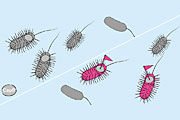New methods to visualize bacterial cell-to-cell communication
Advertisement
Researchers at the University of Basel have developed a live-cell fluorescent labeling that makes bacterial cell-to-cell communication pathways visible. The communication between bacterial cells is essential in the regulation of processes within bacterial populations, such as biofilm development.

Selective labeling of the Burkholderia cenocepacia quorum-sensing receptor CepR.
Illustration aus José Gomes et al., «Fluorescent Labeling Agents for Quorum-Sensing Receptors (FLAQS) in Live Cells» Chem. Eur. J. 2013, 19. Copyright Wiley-VCH Verlag GmbH & Co. KGaA. Reproduced with permission.
Most bacteria are able to communicate with each other by secreting signaling molecules. Once the concentration of signals has reached a critical density («the Quorum), the bacteria are able to coordinate their behavior. Only when this critical population density has been reached certain genes are activated that lead to, for example, the formation of biofilms or the expression of virulence factors. Bacteria utilize this so-called «Quorum Sensing» (QS) to synchronize their behavior to regulate functions that benefit the entire population.
The most commonly used signaling molecules are N-Acyl-L-homoserine lactones (AHLs) that are secreted by the bacteria into their surroundings, where they can easily be incorporated by other cells. The AHLs then start binding to specific QS-receptors once a certain density has been reached inside the cell.
Fluorescent labeling of signaling compound to visualize receptors
The research groups under the leadership of Prof. Karl Gademann (University of Basel) and Prof. Leo Eberl (University of Zurich) have succeeded in visualizing live cell-to-cell communication pathways. The scientists added fluorescents tags to natural AHL signaling molecules and were able to show through tests with bacterial cultures that the modified signaling molecule selectively binds to the Burkholderia cenocepacia QS receptor.
B. cenocepacia is a member of a bacterial group known to form biofilms in the lungs of immunocompromised persons or patients suffering from cystic fibrosis, causing severe complications such as pneumonia.
The scientists were also able to detect the receptor in a native population of B. cenocepacia. Here, the natural AHL signaling molecule is competing with its artificial analogue for the binding to the receptor. The fluorescent-labeling agent was equally distributed over the live cell, which made it possible to localize the receptor inside the cytoplasm for the first time.
Broad application possibilities
Using fluorescently labeled AHL analogues represent an operationally simple tool for the imaging of QS receptors in live cells. Thus, this new method could be used for a broad range of applications, such as the fast analysis of QS in various environmental and clinical samples. Furthermore, it might lead to a better understanding of the communication between bacteria and host as well as of the cell-to-cell communication in bacteria populations.

























































